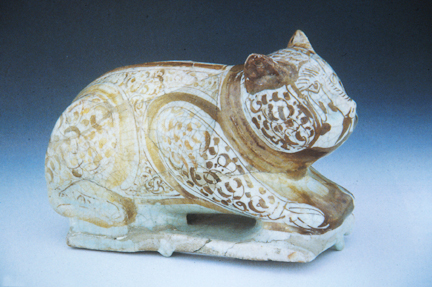The Seljuk Turks from Central Asia were to conquer Iran, Iraq, Syria and all of Asia Minor, and created a period of relative stability. During this time, the Middle East was exposed to imports of Song dynasty porcelain, and the novelty and beauty of this pottery was highly sought after by ruling monarchs. Unable to duplicate the porcelain clay body or its firing procedure, local potters nonetheless attempted, and were able to create a simulation, called fritware. Fritware is, in a sense, 'soft paste' porcelain. A frit is merely a flux, a material that when added to a clay or a glaze, acts to lower the melting or fusing temperature. In this case the frit was a ground glass that was added to the clay body to increase its fusion (vitrification). While not completely successful in achieving all the qualities of porcelain, it was reasonably dense and durable, and presented a beautiful, white surface on which to paint. Fritware bodies are low in clay, and thus not very plastic, or workable, but such a clay is fine for use in molding, such as this cat from Kashan.
Lusterware is believed to have been first discovered in Egypt approximately 700-800 CE by glass blowers. The art spread to Mesopotamia, and eventually was tried on glaze surfaces to great effect. A luster is nothing more than a film of metal (usually gold, silver, platinum, copper, or bismuth) that is fused onto the surface of a fired glaze. The result is an iridescent glow of metal that catches the light and adds considerable surface richness. The effect is analogous to overglaze enamel (china paint) in that it is fused onto the glaze, not into. As such, the effect is subject to abrasion and will fade in contact with direct sunlight. The firing of such lusters is critical: too hot, and the luster will burn away; too cool and the luster remains mat, with no shine.The process involves preparing the luster by mixing the sulfates of the above mentioned metals with ocher clay, which will serve as the vehicle in applying the luster. To an already glaze fired surface, this mixture is painted and the piece fired a third time to fuse the luster onto the glaze. The firing must be a smoky, reduction flame. After firing (below 1200° F) the piece is removed from the kiln. Lustered areas appear as a dull, metallic film. Burnishing the areas removes the remaining ocher vehicle, and reveals the brilliant, shining luster. Affects will fade over time, so we are not seeing the original color on this cat. It would have been considerably brighter. A contemporary observer, Abu'l Qasim, writing in the 12th century, described lusterware as 'reflecting like red gold and shining like the light of the sun.'

Earthenware Cat from Kashan, Fritware with Luster, 8", 12th Century


